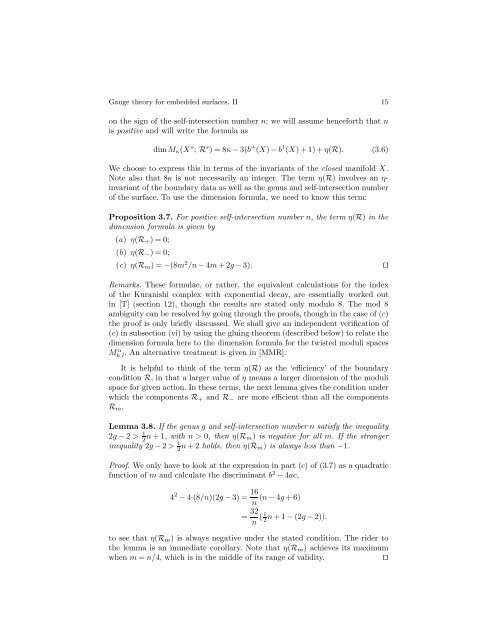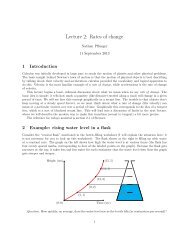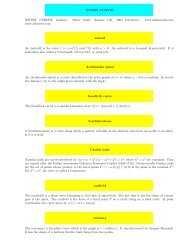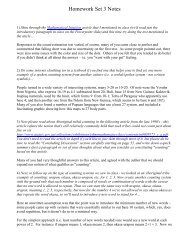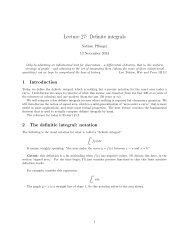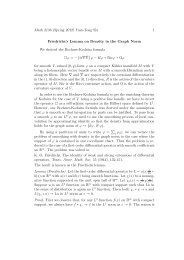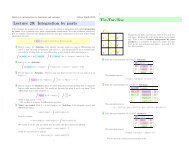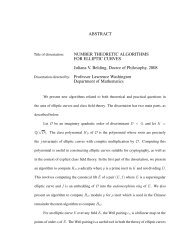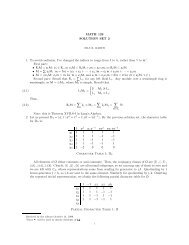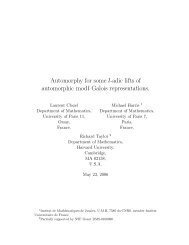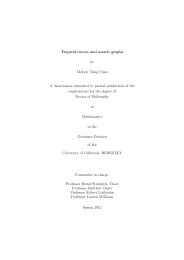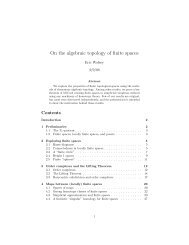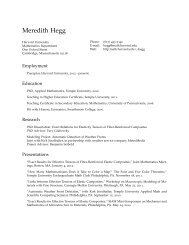Gauge theory for embedded surfaces, II
Gauge theory for embedded surfaces, II
Gauge theory for embedded surfaces, II
Create successful ePaper yourself
Turn your PDF publications into a flip-book with our unique Google optimized e-Paper software.
<strong>Gauge</strong> <strong>theory</strong> <strong>for</strong> <strong>embedded</strong> <strong>surfaces</strong>, <strong>II</strong> 15<br />
on the sign of the self-intersection number n; we will assume hence<strong>for</strong>th that n<br />
is positive and will write the <strong>for</strong>mula as<br />
dim Mκ(X o ; R s )=8κ−3(b + (X) − b 1 (X)+1)+η(R). (3.6)<br />
We choose to express this in terms of the invariants of the closed manifold X.<br />
Note also that 8κ is not necessarily an integer. The term η(R) involvesanηinvariant<br />
of the boundary data as well as the genus and self-intersection number<br />
of the surface. To use the dimension <strong>for</strong>mula, we need to know this term:<br />
Proposition 3.7. For positive self-intersection number n, thetermη(R)in the<br />
dimension <strong>for</strong>mula is given by<br />
(a) η(R+)=0;<br />
(b) η(R−)=0;<br />
(c) η(Rm)=−(8m2 /n − 4m +2g−3). ⊓⊔<br />
Remarks. These <strong>for</strong>mulae, or rather, the equivalent calculations <strong>for</strong> the index<br />
of the Kuranishi complex with exponential decay, are essentially worked out<br />
in [T] (section 12), though the results are stated only modulo 8. The mod 8<br />
ambiguity can be resolved by going through the proofs, though in the case of (c)<br />
the proof is only briefly discussed. We shall give an independent verification of<br />
(c) in subsection (vi) by using the gluing theorem (described below) to relate the<br />
dimension <strong>for</strong>mula here to the dimension <strong>for</strong>mula <strong>for</strong> the twisted moduli spaces<br />
M α k,l . An alternative treatment is given in [MMR].<br />
It is helpful to think of the term η(R) as the ‘efficiency’ of the boundary<br />
condition R, in that a larger value of η means a larger dimension of the moduli<br />
space <strong>for</strong> given action. In these terms, the next lemma gives the condition under<br />
which the components R+ and R− are more efficient than all the components<br />
Rm.<br />
Lemma 3.8. If the genus g and self-intersection number n satisfy the inequality<br />
2g − 2 > 1<br />
2n +1,withn>0,thenη(Rm)is negative <strong>for</strong> all m. Ifthestronger<br />
inequality 2g − 2 > 1<br />
2 n +2 holds, then η(Rm) is always less than −1.<br />
Proof. We only have to look at the expression in part (c) of (3.7) as a quadratic<br />
function of m and calculate the discriminant b 2 − 4ac,<br />
4 2 − 4·(8/n)(2g − 3) = 16<br />
(n − 4g +6)<br />
n<br />
= 32<br />
n<br />
1 ( 2n +1−(2g − 2)),<br />
to see that η(Rm) is always negative under the stated condition. The rider to<br />
the lemma is an immediate corollary. Note that η(Rm) achieves its maximum<br />
when m = n/4, which is in the middle of its range of validity. ⊓⊔


